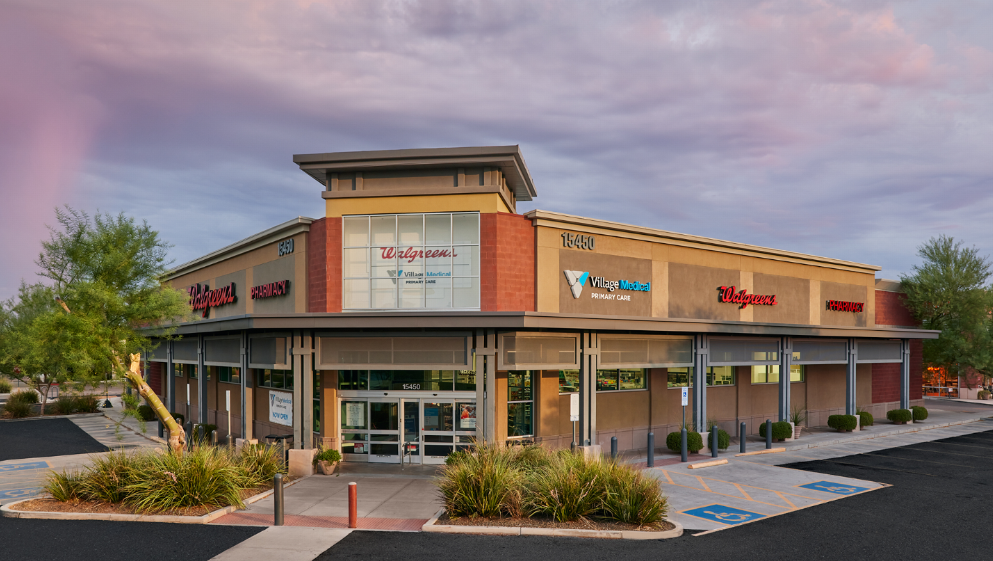Walgreens stock jumps 27% after earnings surpass estimates. Analysts see early signs of recovery
Editor’s Note: This story has been updated following Walgreens’ earnings call
Walgreens shares jumped Friday, despite a $265 million loss in the latest quarter, as the drugstore chain also posted better sales and adjusted profits than analysts expected.
The company is executing a turnaround plan to improve its financial performance that includes closing 1,200 stores, controlling operating costs and addressing reimbursement models.
“Our first quarter results demonstrate that we are executing against our long-term strategic priorities. Importantly, we believe our approach to 2025 payer contracting supports our expectation for future stabilization in our pharmacy business, and we’re still in the early stages of getting to a better outcome on our drug procurement costs,” Tim Wentworth, Chief Executive Officer at Walgreens Boots Alliance, told investors during the company’s fiscal 2025 first-quarter earnings call Friday.
“We’re also executing on items that are in our control. Our initial wave of store closures has performed better than expected on multiple facets, including script retention and employee engagement. This gives us increased confidence in our centralized, deliberate approach to this process. Also fundamental to our turnaround is financial discipline. While we are pleased with our first quarter results, there is more work to be done as we aim to strengthen our balance sheet and to ensure longer-term positive cash flow generation. We remain committed to achieving a retail pharmacy-led turnaround underpinned by a sustainable economic model,” he said.
Walgreens’ turnaround “will take time,” Wentworth cautioned investors and analysts. “As the quarter’s results demonstrate, we are executing with urgency and believe the actions we’re taking will be the basis for sustained value creation over the long term,” he said.
The company is maintaining fiscal 2025 adjusted earnings per share guidance of $1.40 to $1.80 per share.
Walgreens had a rocky 2024 as it faced a challenging retail environment. Its stock was the worst-performing stock in the S&P 500 last year, losing over 60% of its value.
The company’s first quarter sales increased 7.5% from the same quarter a year ago to $39.5 billion, up 6.9%, reflecting sales growth across all business segments.
Net loss in the first quarter was $265 million compared to a net loss of $67 million a year ago, primarily driven by higher operating loss. Loss per share was 31 cents compared to loss per share of 8 cents in the year-ago quarter.
The pharmacy chain was expected to report $37.33 billion in sales for the quarter, up from $36.71 billion the same time last year, according to estimates compiled by Visible Alpha. Walgreens was projected to report a net loss per share of 2 cents compared to 8 cents last year.
Walgreens recorded an adjusted net income of $440 million, or 51 cents per share, well above the $329 million and 38 cents per share analysts had expected.
The retail pharmacy giant closed 70 stores during its fiscal 2025 first quarter and plans to close around 450 stores throughout 2025, as it works to improve its cash flow, Wentworth told investors.
The most recent results lifted shares by reflecting a “much-needed stabilization for the firm,” Keonhee Kim, equity analyst at Morningstar, wrote in a note Friday.
“While neither the solid earnings nor the surging stock expedite our expected timeline for Walgreens’ eventual turnaround, we do think a continued execution on the footprint optimization plan and a more consistent readout of stable performance should continue to lift the depressed stock going forward,” Kim wrote. “After a long period of volatility, we think Walgreens still needs a few more quarters of good execution on its strategy to gain investors’ trust, but we believe patient long-term investors can realize the significant upside to our fair value estimate over the medium term.”
The company is focused on stabilizing its core retail pharmacy business, honing its retail strategy and improving operating cash flow and net debt position, Wentworth told investors during the company’s Q4 earnings call in October.
But, like other retail pharmacies, Walgreens is facing significant headwinds as retail sales have slowed from softer consumer spending along with pharmacy reimbursement pressure and hefty losses from its push into primary care with VillageMD.
The VillageMD business is not yet profitable and its waning value contributed to Walgreen’s hefty $6 billion loss in its fiscal 2024 second quarter. In a regulatory filing back in August, the company said it was exploring options including a sale of all or part of the VillageMD businesses, possible restructuring options and other strategic opportunities, according to the filing.
The company is moving forward with its sale of VillageMD, as Wentworth said Friday a sale of the VillageMD business is “underway,” but he did not provide more details on the potential acquirer.
The VillageMD portfolio includes urgent and primary care chain Summit Health-CityMD after VillageMD bought those assets in a deal worth close to $9 billion in 2022.
“We are continuing to evaluate the best options for Summit Health-CityMD. We are encouraged by the leadership of new CEO healthcare veteran Jim Murray. To be clear, our ultimate intent to exit is unchanged, and we remain committed to redeploying any proceeds to reduce our net debt and improve the health of our balance sheet.”
Walgreens’ U.S. healthcare segment brought in $2.2 billion in revenue in Q1, up 12% compared to a year ago, with growth in all businesses, the company said. VillageMD sales were up $1.6 billion, growing 9%, boosted by risk-based and fee-for-service business, Manmohan Mahajan, Walgreens Boots Alliance’s global chief financial officer, said during the earnings call.
CareCentrix was up 16% and Shields, its specialty pharmacy segment, rose 30% during the most recent quarter.
Operating loss was $325 million compared to $436 million in the prior year period reflecting improved performance at VillageMD and Shields, Walgreens said in the Q1 financial report.
Adjusted EBITDA of $70 million improved by $109 million versus the prior year quarter reflecting higher contribution from VillageMD risk-based and fee-for-service business and growth at Shields.
The Wall Street Journal reported in December that Walgreens was in talks with private equity firm Sycamore Partners for a deal that would take the company private following years of financial woes. People familiar with the conversations told the WSJ the deal could come together early next year should discussions prove fruitful.
Emarketer analyst Rajiv Leventhal noted that Walgreens’ Q1 2025 earnings report “solidifies that the company’s turnaround is officially underway.”
“CEO Tim Wentworth’s comments on being committed to a retail pharmacy-led operating model that will drive long-term value indicate that the rumored sale to PE firm Sycamore Partners is less likely,” Leventhal said in written commentary Friday. “Investors are more bullish now, as evidenced by a ~15% jump in the company’s stock price following this morning’s earnings report that beat analysts’ estimates. That’s likely driven by Walgreens’ go-forward strategy of closing stores and cutting costs until it lands on the ideal number of physical locations that will allow the company to invest in delivering a better pharmacy and front-of-store customer experience.”
Walgreens also is strategically negotiating with pharmacy benefit managers and payers to address reimbursement models, Wentworth told investors and analysts.
“We have now completed all of the contract negotiations for calendar 2025 and the nature of these conversations has evolved. We’ve had success in adjusting contract dynamics in our negotiations with our commercial Medicare and Medicaid plans, such as rebalancing brands and generics and carving out new categories for high-cost drugs all in response to the evolving needs of customers and to better align reimbursement with our cost of goods,” he said Friday. “We are also expanding discussions about being compensated for additional services beyond dispensing and promoting alternative payment models.”
“Our goal is to serve as many patients and communities as possible, but this is dependent on being reimbursed fairly so that we can maintain our presence as a healthcare provider across the country,” he said.
Details on Q1 financial results
Walgreens reported a loss of $265 million in its fiscal first quarter, which ended November 30, as it executes an ongoing turnaround strategy and continues to struggle with lower retail sales.
“Our first quarter results reflect our disciplined execution against our 2025 priorities: stabilizing the retail pharmacy by optimizing our footprint, controlling operating costs, improving cash flow and continuing to address reimbursement models,” Tim Wentworth, Chief Executive Officer at Walgreens Boots Alliance said in a press release issued Friday morning. “While our turnaround will take time, our early progress reinforces our belief in a sustainable, retail pharmacy-led operating model.”
Walgreens’ adjusted operating income in Q1 was $593 million compared to adjusted operating income of $687 million last year. Walgreens said the increase in operating loss reflects higher costs related to its footprint optimization program in the U.S. retail pharmacy segment, and both operating loss and adjusted operating income reflect lower U.S. retail sales and lapping prior year sale-leaseback gains, partly offset by cost savings initiatives and growth in the U.S. healthcare segment.
The company’s U.S. retail pharmacy segment brought in $30.9 billion in revenue, up 6.6% from a year ago.
Pharmacy sales increased 10.4%, benefiting from higher branded drug inflation and prescription volume. Total prescriptions filled in the quarter, including immunizations, adjusted to 30-day equivalents increased 1.5% to 316.3 million.
Retail sales were down 6.2% from a year ago, reflecting a weaker cough cold flu season and lower sales in discretionary categories.
Adjusted operating income in the segment decreased 36.4% to $441 million compared to $694 million from the same period a year ago.
The company’s international business segment had first quarter sales of $6.4 billion, an increase of 10.2% from the year-ago quarter. Adjusted operating income increased 17.9% to $168 million, led by strong retail performance in Boots UK and growth in Germany, partly offset by cost inflation and technology investments.





